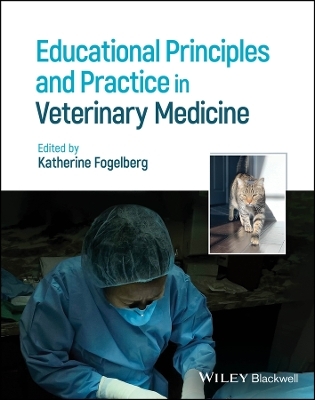
Cooperative Veterinary Care
Wiley-Blackwell (Verlag)
978-1-394-16359-5 (ISBN)
Every pet needs medical care in the veterinary clinic and husbandry at home. Fear and stress can present significant barriers to good care while also compromising safety for animal care professionals and pet owners. It’s possible to help pets learn to allow and even willingly participate in veterinary care, husbandry, and grooming. With a foundation in learning theory and emphasizing practical techniques, Cooperative Veterinary Care is a groundbreaking guide to encouraging voluntary participation in veterinary care. Now updated to reflect the latest research and clinical information drawing on years of professional hands-on experience, it’s a must-own for any small animal practice or pet professional looking to increase patient comfort and facilitate excellent care.
Foundations of learning and training to prepare any professional to get started right away
Unique exploration of the veterinary environment and how Cooperative Veterinary Care can help
Integration of the Fear Free(sm) Spectrum of Fear, Anxiety & Stress to quantify patient experiences
Step by step training plans for veterinary care and husbandry with photo and video demonstrations
Practical applications for all common procedures.
Foundation techniques which can be expanded to virtually any veterinary care or animal husbandry and grooming need
Cooperative Veterinary Care is written for the veterinary professional team but will help anyone and everyone who cares for and interacts with pets.
Monique Feyrecilde BA, LVT, VTS (Behavior) is a Veterinary Technician Specialist in Behavior working full time in the veterinary clinic setting. Her special interests are applied animal behavior of all species and promoting both the emotional and physical wellbeing of animals. Monique is the founder and owner of Teaching Animals near Seattle, Washington, USA and online at www.teachinganimals.com
Preface xiii
Acknowledgments xv
About the Companion Website xvii
1 Introduction to Patient Centered Veterinary Care 1
1.1 First, Do No Harm 1
1.1.1 Veterinary Technician’s Oath 1
1.1.2 Veterinarian’s Oath 1
1.2 Stress, Fear, and the Veterinary Clinic 2
1.3 Freedom, Wants, and Needs 2
1.4 Iatrogenic Behavioral Injury 3
1.5 Focusing on Welfare Rather than Animal Restraint 4
References 9
2 Perception and Communication 11
2.1 Sensation and Perception 11
2.1.1 Vision 11
2.1.1.1 Canine Vision 12
2.1.1.2 Cat Vision 13
2.1.2 Hearing 13
2.1.2.1 Dog Hearing 13
2.1.2.2 Cat Hearing 15
2.1.3 Olfaction and Pheromones 15
2.1.3.1 Dog Olfaction and Pheromones 16
2.1.3.2 Cat Olfaction and Pheromones 16
2.1.3.3 Touch 16
2.1.3.4 Dog and Cat Touch 17
2.1.4 Taste 18
2.1.4.1 Dog and Cat Taste 18
2.1.4.2 Individual Variations: Nature and Nurture 18
2.2 Stress and Fear 18
2.3 Body Language 20
2.3.1 Evaluation Tools 21
2.3.2 Dog Body Language 23
2.3.2.1 Relaxed or Calm, Dog (FAS 0–1) 23
2.3.2.2 Mild Stress, Dog (FAS 1–2) 27
2.3.2.3 Moderate Stress, Dog (FAS 3) 29
2.3.2.4 Severe Stress, Dog (FAS 4–5) 31
2.3.3 Cat Body Language 34
2.3.3.1 Relaxed or Calm, Cat (FAS 0) 34
2.3.3.2 Mild Stress, Cat (FAS 1–2) 36
2.3.3.3 Moderate Stress, Cat (FAS 2–3) 38
2.3.3.4 Severe Stress, Cat (FAS 4–5) 38
2.4 Causes of Stress in the Veterinary Setting 40
2.4.1 Overview 40
2.4.2 Pain 40
2.4.3 Examination and Treatments 41
2.4.4 Emotional Capital and Trigger Stacking 42
2.4.5 Learning History 43
2.4.5.1 Normalizing Welfare for All 43
2.4.6 Steps for Success 44
References 45
3 Learning, Conditioning, and Training 47
3.1 Classical Conditioning 48
3.2 Operant Conditioning 51
3.2.1 Reinforcement 52
3.2.2 Positive Reinforcement 52
3.2.2.1 Example: Acquiring a Body Weight 52
3.2.2.2 Example: Teaching a Kitten to Target 52
3.2.3 Negative Reinforcement 53
3.2.3.1 Example: Fastening a Safety Belt 53
3.2.3.2 Example: Teaching an Animal to Stand Still When Restrained 53
3.2.4 Punishment 53
3.2.4.1 Negative Punishment 54
3.2.4.2 Positive Punishment 54
3.2.5 The Role of Marker-based Training 55
3.2.5.1 Marker-based Training: Mechanics Matter 56
3.2.5.2 Marker-based Training: Capturing 57
3.2.5.3 Marker-based Training: Shaping 59
3.3 Habituation, Sensitization, Desensitization, Counter Conditioning, and More 60
3.3.1 Habituation 60
3.3.2 Sensitization 60
3.3.2.1 Flooding 61
3.3.3 Desensitization, Classical Conditioning, Classical Counter Conditioning, and Operant Counter Conditioning 61
3.3.3.1 Desensitization 61
3.3.3.2 Classical Counter Conditioning 62
3.3.3.3 Operant Counterconditioning 63
3.3.4 Putting It All Together 64
3.3.4.1 Example: Leashing for a Walk 65
3.4 The ABCs of Behavior 65
3.4.1 Functional Assessment 65
3.4.2 Antecedents 66
3.4.3 Behavior 66
3.4.4 Consequences 66
3.4.4.1 Example: A Cat Avoids the Carrier 69
3.5 Fundamental Training Skills 69
3.5.1 Training Plans 69
3.5.2 Rewards and Reinforcement 70
3.5.2.1 Questions About Rewards 70
3.5.2.2 If You Can Use Toys, Petting, and Praise, Then Why Use Food? 71
3.5.2.3 What About Secondary Reinforcers? 73
3.5.3 Building Behaviors: A Good Foundation 74
3.5.4 Foundations for the Trainer 75
3.5.4.1 Methods 75
3.5.5 Modeling 76
3.5.6 Cues and Cueing 78
3.5.7 Foundations for the Learner 79
3.5.7.1 Nose Target 79
3.5.7.2 Paw Targeting – Canine and Feline 82
3.5.7.3 Other Body Targets 85
3.5.7.4 Go to Mat or Go to Station 85
3.5.7.5 The Station as an Introduction to the Concept of Opting In 86
3.5.7.6 Adding Duration 87
3.5.7.7 Attention to the Handler 88
3.5.7.8 Stillness 88
3.6 Conclusion 88
References 89
4 Successful Visits: Environment and Protocols to Prevent Fear and Stress 91
4.1 Setting Up for Success: Before the Visit 91
4.1.1 At Home 91
4.1.2 Making the Appointment 92
4.2 During the Visit 93
4.2.1 Patient Assessment Tools 93
4.2.2 The Lobby: Setup and Equipment 94
4.2.3 The Entrance: Dogs 94
4.2.4 The Scale 96
4.2.4.1 Video: Weighing a Large Dog 98
4.2.5 The Entrance: Cats 98
4.2.6 The Exam Room 98
4.2.7 The Exam Room Experience: Dogs 99
4.2.8 The Exam Room Experience: Cats 102
4.2.9 The Trip Home: Cats 104
4.3 Happy Visits and Other Preventative Planning 105
4.3.1 Happy Visits 105
4.3.2 Puppy and Kitten Visits 105
4.4 Hospitalization, Treatments, Diagnostics, and Boarding 110
4.4.1 Hospitalization 110
4.4.2 Patient Movements 110
4.4.2.1 For Example 111
4.4.3 Dog Wards 112
4.4.4 Cat Wards 113
4.4.5 Treatment Rooms 113
4.4.6 Radiology 117
4.4.7 Anesthesia and Surgery 118
References 119
5 Type One Patients and Training: Distraction Techniques and FAS 0–2 Pets 121
5.1 Introduction to the Types of Training 121
5.2 Identifying Type One Patients (FAS 0–2) 121
5.2.1 Type One Dogs (FAS 0–2) 122
5.2.1.1 Food Acceptance 122
5.2.1.2 Body Language 122
5.2.1.3 Proximity Preference 123
5.2.2 Type One Cats (FAS 0–2) 123
5.2.2.1 Food Acceptance, Toy Acceptance, and Tactile Acceptance 123
5.2.2.2 Body Language 123
5.2.2.3 Proximity Preference 124
5.2.2.4 Criteria and Fundamentals for Distraction Techniques 126
5.3 Type One Training: Dog Exam Room and Examination 128
5.3.1 Reception, Weight, and Moving to the Exam Room 128
5.3.2 The Exam Room 129
5.3.3 Physical Examination 132
5.4 Type One Training: Cat Exam Room and Examination 134
5.4.1 Physical Examination 135
5.5 Type One Training: Injections and Sample Collection 137
5.5.1 Subcutaneous and Intramuscular Injection 138
5.5.2 Venipuncture 139
5.5.2.1 Cephalic 139
5.5.2.2 Lateral Saphenous (Dogs) 140
5.5.2.3 Medial Saphenous (Cats) 140
5.5.2.4 Jugular 140
5.5.3 Blood Pressure Measurement 142
5.5.4 Cystocentesis 143
5.6 Administering Medications and Grooming 145
5.6.1 Medication Stations 145
5.6.2 Oral Medications 145
5.6.3 Ear Examination, Medications, and Cleaning 146
5.6.4 Nail Trims 147
5.6.5 Anal Gland Expression 149
5.7 Conclusion 149
References 150
6 Type Two Patients and Training: Conditioning Plans for FAS 0–3 Pets 151
6.1 Type Two Training: Desensitization, Counterconditioning 151
6.2 Identifying Type Two Patients (FAS 2–3) 151
6.2.1 Type Two Dogs: FAS 0–3 152
6.2.1.1 Food Acceptance 152
6.2.1.2 Body Language 154
6.2.1.3 Proximity Preference 154
6.2.2 Type Two Cats: FAS 0–3 154
6.2.2.1 Food Acceptance, Toy Acceptance, and Tactile Acceptance 154
6.2.2.2 Body Language 154
6.2.2.3 Proximity Preference 155
6.2.2.4 Treats, Treatments, and Timing 156
6.3 Type Two Training: Dog Exam Room and Examination 156
6.3.1 Reception, Weight, and Moving to the Exam Room 157
6.3.2 The Exam Room 157
6.3.2.1 Table Training and Stabilization Training 159
6.3.3 Physical Examination 161
6.4 Type Two Training: Cat Exam Room and Examination 163
6.4.1 The Exam Room 165
6.4.2 Physical Examination 165
6.5 Type Two Training: Injections and Sample Collection 166
6.5.1 Subcutaneous and Intramuscular Injection 167
6.5.1.1 Venipuncture 170
6.5.1.2 Lateral Saphenous (Dogs) 171
6.5.1.3 Medial Saphenous (Cats) 172
6.5.1.4 Jugular 173
6.5.2 Blood Pressure Measurement 173
6.5.2.1 Cystocentesis 174
6.6 Administering Medications and Grooming 174
6.6.1 Medication Stations 174
6.6.2 Oral Medications 175
6.6.3 Ear Medications and Cleaning 175
6.6.4 Eye Medications 178
6.6.5 Nail Trims 180
6.6.6 Anal Gland Expression 181
6.7 Conclusion 183
References 184
7 Type Three Patients and Training: Incorporating Operant Techniques, FAS 0–5 Pets 185
7.1 Type Three Training: Incorporating Operant Techniques 185
7.2 Identifying Type Three Patients (FAS 4–5) 186
7.2.1 Type Three Dogs 187
7.2.1.1 Food Acceptance 187
7.2.1.2 Body Language 187
7.2.1.3 Proximity Preference 187
7.2.2 Type Three Cats 187
7.2.2.1 Food Acceptance, Toy Acceptance, and Tactile Acceptance 189
7.2.2.2 Body Language 189
7.2.2.3 Proximity Preference 189
7.13 Conclusion 237
8 Additional Patient Resources 239
8.1 Introduction 239
8.2 Nutraceuticals and Pharmaceuticals 239
8.2.1 Baseline Medications 239
8.2.2 Event-based Medications 240
8.2.3 Nutraceuticals 241
8.2.4 Acepromazine: Don’t ACE Fear! 241
8.3 Professionals and Their Roles 242
References 243
9 Implementation Strategies 245
9.1 Change Is Never Easy 245
9.2 Proposing Change 245
9.2.1 Identify Solutions 246
9.2.2 Start Small 246
9.2.3 Choose Measurable Changes 246
9.3 Overcoming Obstacles: Common Concerns and Questions 247
9.3.1 Perception: It’s Too Costly 247
9.3.2 Perception: It Takes Too Long 248
9.3.3 Perception: But This Is How We’ve Always Done It 249
9.3.4 Perception: I’m Not Sure What to Do 250
9.3.5 Perception: We Might Make Clients Angry 251
9.3.6 Perception: It’s Hard to Know When to Hit Pause 252
9.3.7 Perception: I Am Afraid 253
9.4 Making Change for the Right Reasons 253
9.4.1 Family Presence for Veterinary Care 254
9.4.1.1 Calming the Patient 255
9.4.1.2 Example Scripts 255
9.5 Conclusion 256
References 256
Index 257
| Erscheinungsdatum | 03.04.2024 |
|---|---|
| Sprache | englisch |
| Maße | 178 x 254 mm |
| Gewicht | 590 g |
| Themenwelt | Veterinärmedizin |
| ISBN-10 | 1-394-16359-2 / 1394163592 |
| ISBN-13 | 978-1-394-16359-5 / 9781394163595 |
| Zustand | Neuware |
| Haben Sie eine Frage zum Produkt? |
aus dem Bereich


